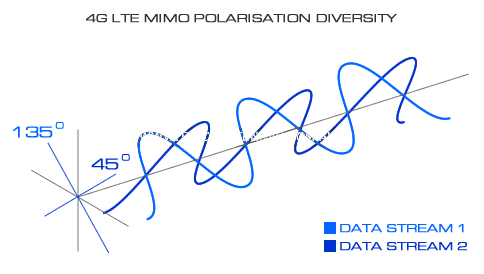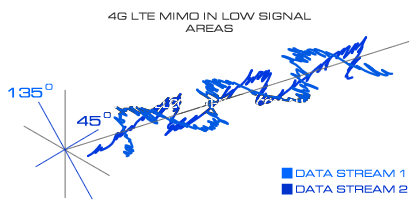Guide to 4G Antennas and MIMO
4G antennas
Your carrier's 4G network only provides high speed Internet.
Your mobile phone or modem might display '4G' on its box or case, but this simply means that it can connect to the Internet via 4G in enabled areas.
Check your carrier's Coverage Map to determine whether you will be operating within their 4G coverage zone before going any further.
If you're in a rural area or if you're travelling, you do not need a 4G antenna, please visit the section of our website that best matches your application.
What type of antenna?
There are two new frequencies to consider - 700MHz (Band 28) and 2600MHz (Band 7).
The 700MHz is a long range, wide coverage network.
The downside is that a base station can only fit the same number of subscribers, but now covers a significantly larger geographic area. This means that the 700MHz will be a lower speed network due to the higher number of expected users, so to achieve the best speed possible we have to get a little tricky.
Multiband antennas
While the network configuration is already set with a band preference of 2600 first, 1800, and 700MHz last, higher performance will be achieved by selecting an antenna that has a higher gain in the upper bands, so that the modem may achieve a connection to these networks to provide a higher capacity connection.
To take advantage of these network features, you'll notice many of the antennas listed on our site operate across multiple bands, usually in the form of a high performance panel or LPDA.
The downside of all multiband antennas is that to increase the operating bandwidth you must reduce antenna gain, or, have a very large and heavy antenna.
To retain practicality, our multiband antennas have a maximum gain of about 10-11dBi.
We do supply a 13.5dBi 700-2700MHz panel antenna, however it measures 680 x 425 x 135mm and weighs over 12kg, so it's impractical for most rooftops.
High gain antennas
Long range 4G connections are possible using high gain antennas.
High antenna gain can come at a cost of frequency bandwidth, meaning at ranges in excess of 20km, you will have to pick one frequency to operate.
Because not all 4G base stations will broadcast all 4G frequencies, it's important to do the research and find out what frequency is being operated at the target base station before selecting an antenna.
This exercise can be complex, we can, however, take care of this for you by completing a Computer Modelling Survey. Otherwise check out our range of high gain dish, grid, and Yagi antennas in our 4G Antenna section.
4G bandwidth (i.e. the width of frequencies we can send and receive on) is critical in supporting high speed and a high number of users.
So that your connection doesn't get confused with another, each user is allocated a small sliver of frequencies they can exclusively use.
You'll notice this most during peak usage hours - as more people start using the tower, it will reduce the width of your (and everyone else's) sliver of frequencies, resulting in each person getting a reduced download/upload speed.
This is a very simplified explanation - if you'd like to learn more here is some information on OFDMA and SCFDMA.
MIMO
The second most important feature of a 4G antenna is the capability to operate in MIMO.
4G uses a technology called MIMO, which means 'Multiple Input Multiple Output' - this is where your modem uses two separate antennas at once to deliver super fast speeds.

Normal 3G and Next-G signals broadcast vertically polarised, where the wave travels "up and down".
LTE MIMO waves are slant polarised, where each wave is rotated 45 degrees from the horizontal, mirrored so the first is at 45 degrees and the other at 135 degrees.
This smart little trick is called polarisation diversity and allows your modem to distinguish two independent streams of data over the same frequency allocated by the cell tower.
Because our modem has two internal antennas each responsible for receiving one stream of data, it is absolutely crucial we have two separate external antennas.
We cannot use a 'Y' patch lead or some other trick to connect both ports of the modem into one antenna, nor can we connect both external antennas into one port.

MIMO is switched on and off by the modem. The decision to use MIMO is negotiated with the cell tower, whereby the quality of the received and transmitted signals are assessed (a metric known as CQI).
When signal strength or quality is low, it's difficult for the modem to distinguish between the two data streams, so when signal levels drop below a certain threshold level, MIMO is switched off and the modem operates with only one antenna.
Interference - why the fuss?
The distinction between signal quality and signal strength should not be overlooked.
Strength refers to the total available power (amplitude) of the measured waveform, whereas quality refers to the degree in which information can be correctly interpreted from that waveform.
The measure of most importance is the C/I+N Ratio (or SINR) as 4G negotiates its radio bearer index based off the strength of the interpreted carrier signal over the interference+noise level (well, indirectly) - so the lower the interference, the higher the C/I+N, and consequently the faster the modulation and coding scheme.
The most prominent source of interference on a 4G network is self-interference - i.e. interference from other sectors on the base station, and other base stations themselves.
Other sources of interference can be systematic (natural) and include thermal, gamma radiation, or hostile (unnatural), including machinery, high voltage transmission, illegal boosters, etc.
How does an antenna help?
Beamwidth. By focusing the transmission beam to a particular direction we increase strength in one direction at the cost of all others.
We can use this to mitigate unnatural sources of interference such as nearby machinery generating wideband noise, or minimise self interference by decreasing strength in the direction of the interfering base station - all while simultaneously increasing strength in the direction of the target base station.
As you can see we've increased C while simultaneously reducing both I and N, resulting in a higher MCS index (called a Radio Bearer index in LTE), resulting in higher symbol rate and higher code rate.
